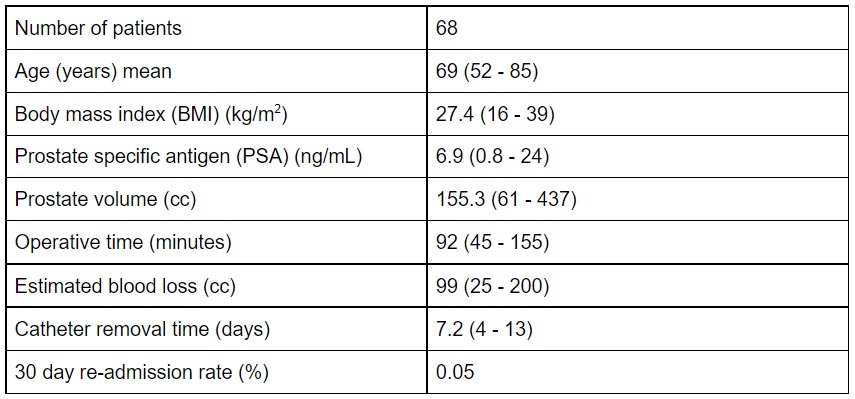Back
Poster, Podium & Video Sessions
Video
V02: BPH/Male Voiding Dysfunction/Infection/ Misc. Imaging
V02-05: Robotic Transvesical Simple Prostatectomy: Our Experience and Technique
Friday, May 13, 2022
10:10 AM – 10:20 AM
Location: Video Abstracts Theater
Shirin Razdan*, Burak Ucpinar, Kennedy E. Okhawere, Indu Saini, New York City , NY, Tara Tomy, New York, NY, Ketan K. Badani, New York City , NY
- SR
Shirin Razdan, MD
Icahn School of Medicine at The Mount Sinai Hospital
Video Presenter(s)
Introduction: In this video, we present the outcomes of patients treated with robotic transvesical simple prostatectomy and demonstrate our technique.
Methods: We performed robotic transvesical simple prostatectomy on 68 consecutive patients. Patients were evaluated in terms of age, body mass index (BMI), prostate volume, prostate specific antigen (PSA), operative time, estimated blood loss, length of hospital stay and catheter removal time. Our technique is demonstrated in a 75 year old male with 300 cc prostate. After achieving pneumoperitoneum and placing the trocars, bladder is insufflated with air and a vertical cystotomy incision is made. Marionette sutures are placed on four quadrants to secure the bladder opening during the procedure. Then, median lobe is grasped and mucosa overlying the median lobe is incised. After identifying the appropriate plane between prostate adenoma and capsule, dissection is carried out circumferentially and adenoma is removed. After achieving hemostasis, complete circumferential mucosa to mucosa anastomosis between the bladder neck and the urethra is completed. Marionette sutures are then removed and the cystotomy is closed in 2 layers.
Results: We used the same robotic transvesical simple prostatectomy technique in 68 consecutive patients with benign prostatic hyperplasia. The demographic and outcome data are presented in Table 1
Conclusions: Robotic transvesical simple prostatectomy is a safe and effective procedure for the treatment of large benign prostatic hyperplasia, with very low complication rates and short hospitalization.
Source of Funding: None

Methods: We performed robotic transvesical simple prostatectomy on 68 consecutive patients. Patients were evaluated in terms of age, body mass index (BMI), prostate volume, prostate specific antigen (PSA), operative time, estimated blood loss, length of hospital stay and catheter removal time. Our technique is demonstrated in a 75 year old male with 300 cc prostate. After achieving pneumoperitoneum and placing the trocars, bladder is insufflated with air and a vertical cystotomy incision is made. Marionette sutures are placed on four quadrants to secure the bladder opening during the procedure. Then, median lobe is grasped and mucosa overlying the median lobe is incised. After identifying the appropriate plane between prostate adenoma and capsule, dissection is carried out circumferentially and adenoma is removed. After achieving hemostasis, complete circumferential mucosa to mucosa anastomosis between the bladder neck and the urethra is completed. Marionette sutures are then removed and the cystotomy is closed in 2 layers.
Results: We used the same robotic transvesical simple prostatectomy technique in 68 consecutive patients with benign prostatic hyperplasia. The demographic and outcome data are presented in Table 1
Conclusions: Robotic transvesical simple prostatectomy is a safe and effective procedure for the treatment of large benign prostatic hyperplasia, with very low complication rates and short hospitalization.
Source of Funding: None


.jpg)
.jpg)